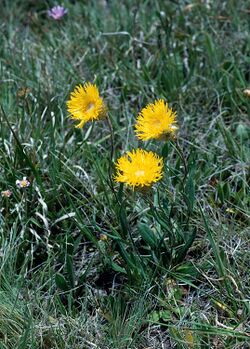Biology:Podolepis decipiens
| Deceiving copper wire-daisy | |
|---|---|

| |
| Scientific classification | |
| Kingdom: | Plantae |
| Clade: | Tracheophytes |
| Clade: | Angiosperms |
| Clade: | Eudicots |
| Clade: | Asterids |
| Order: | Asterales |
| Family: | Asteraceae |
| Genus: | Podolepis |
| Species: | P. decipiens
|
| Binomial name | |
| Podolepis decipiens Jeanes[1]
| |
Podolepis decipiens, commonly known as deceiving copperwire-daisy,[2] is a flowering plant in the family Asteraceae and grows in Victoria, Tasmania and New South Wales. It is an upright, perennial herb with yellow daisy-like flowers on a single stem rising from a sparse rosette.
Description
Podolepis decipiens is a perennial herb to 70 cm (28 in) high with a single upright or several woolly stems from a rootstock that is renewed yearly. The leaves are covered sparsely to densely with flattened hairs, margins more or less flat to rolled under, upper surface rough, basal leaves in a sparse rosette, lance, oblong, oval or egg-shaped, 3–20 cm (1.2–7.9 in) long, 5–30 mm (0.20–1.18 in) wide, leaves toward apex stem-clasping, sessile, mostly linear to linear to lance-shaped, usually 1–10 cm (0.39–3.94 in) long and 2–15 mm (0.079–0.591 in) wide. The flowers are bright yellow or orange, usually single, with 20-40 fringed petals, mostly 20–40 mm (0.79–1.57 in) in diameter, bracts papery in several rows and on a peduncle 4–10 cm (1.6–3.9 in) long. Flowering occurs from August to February and the fruit is a cypsela 2–4 mm (0.079–0.157 in) long, about 1 mm (0.039 in) wide and covered with barbed bristles.[2][3][4]
Taxonomy and naming
Podolepis decipiens was first formally described in 2015 by Jeffrey A. Jeanes and the description was published in Muelleria.[5][6] The specific epithet (decipiens) means "deceiving" because in has been confused with Podolepis jaceoides.[6][7]
Distribuiton and habitat
Deceiving copper wire-daisy is a widespread species found in a variety of habitats including grasslands, woodlands, forests, alpine and near coastal locations in New South Wales, Victoria, Tasmania, South Australia and Queensland.[3][4]
References
- ↑ "Podolepis decipiens". Australian Plant Census. https://biodiversity.org.au/nsl/services/apc-format/display/3662181.
- ↑ 2.0 2.1 "Podolepis decipiens". Australian Plant Society Tasmania. https://www.apstas.org.au/flora-1/6482gddta68adgg-gzae3-ymfnw-h2jlx-ztnde-8cyzn.
- ↑ 3.0 3.1 "Podolepis decipiens". Royal Botanic Gardens Victoria. https://vicflora.rbg.vic.gov.au/flora/taxon/1129a852-5c51-4c6a-84a5-4ce195f356ec.
- ↑ 4.0 4.1 Murray, Louisa. "Podolepis decipiens". Royal Botanic Gardens Sydney. https://plantnet.rbgsyd.nsw.gov.au/cgi-bin/NSWfl.pl?page=nswfl&lvl=sp&name=Podolepis~decipiens.
- ↑ "Podolepis decipiens". Australian Plant Name Index. https://biodiversity.org.au/nsl/services/rest/instance/apni/3663323.
- ↑ 6.0 6.1 Jeanes, Jeffrey (2015). "Podolepis decipiens". Muelleria 33: 26-28. https://www.biodiversitylibrary.org/page/59608981#page/27/mode/1up. Retrieved 12 March 2023.
- ↑ George, A.S; Sharr, F.A (2021). Western Australian Plant Names and their meanings (4th ed.). Kardinya: Four Gables. p. 183. ISBN 9780958034197.
Wikidata ☰ Q63171066 entry
 |

